
There are major differences in competitiveness among the diverse species that make up the global animal protein supply. The winners in this competitive battle are the species that are both highly desired by consumers and efficient to produce.
Global protein production trends clearly show who is winning and who is falling behind. If 1990-2014 growth rates persist, chicken will overtake pork as the No. 1 meat by about 2020. In the not-too-distant future aquaculture could overtake chicken.
Dramatic differences in growth rates among proteins
Within total protein supply, ability to compete is revealed by production trends. The fastest growing species are those that are suitable for large scale production and the most feed-efficient. (See Figure 1)

FIGURE 1: If growth rates persist, chicken could overtake pork as the most-consumed meat by about 2020.
Figure 1 contains 1990 through 2014 Compound Annual Growth Rates (CAGR) history for the major meats, eggs, aquaculture (farmed fish and shrimp), several minor meat categories, plus global population. The items are sorted from fastest to slowest growth rate. The only item growing slower than population is beef and buffalo. The clear majority of that category is beef. Total meat, egg and aquaculture production is growing 1.5 percentage points faster than population, indicating a 1.5 percent annual global per capita growth. Beef and buffalo production is growing much slower than global population, and average per capita consumption is shrinking.
Feed efficiency drives growth
Looking at the table’s CAGR rankings, the higher ranked categories are generally the most feed efficient protein producers, and lower ranked are less feed efficient. Feed efficiency is related to production cost. A major exception is turkey, ranked near the CAGR bottom, but more feed efficient than pork.
Another important factor is consumer acceptance. The fastest growing species are almost universally acceptable. That would include all poultry products and fish. Beef and pork both face significant religious and cultural barriers that limit demand in some parts of the world. Despite excellent feed efficiency, turkey meat has just never caught on outside North America and parts of Europe.
Ruminants rank very low on global growth rate despite being able to convert grass to meat. It has been argued that the ability to utilize grass that would otherwise not be used for food production is a ruminant competitive advantage. The downside for ruminants is that the requirement for grazing land also limits scale of operation - unless the animals are confined and fed compound feeds. Ruminants are not as efficient as monogastric animals in converting grains and oilseeds into meat. The result is that, in general, ruminants are not cost competitive with modern aquaculture, poultry and pig systems.
Trend projections for proteins
Looking at long-term production trends, aquaculture and poultry are clearly winning the competitive battle for share of the global farmed animal protein market. The battle is almost entirely one-sided. Only pork is even close to keeping up. (See Figure 2)

FIGURE 2: Long-term production trends show poultry and aquaculture holding much of the share of the global farmed animal protein market.
Projections in the chart are based on the same 1990-2014 compound average growth rates contained in the table, not the entire FAO 1961-2014 dataset. This data subset is employed primarily due to the dramatic slowdown in beef and buffalo production growth that occurred in about 1980. Using pre-1980 data overestimates projected 2025 beef production.
Aquaculture is defined here to include farmed fish and shrimp. Growth rates are more than triple pork, and five or more times than that of ruminants. Those who have not looked at aquaculture recently may be surprised at both its scale and growth rate. That may be because it is largely an Asian phenomenon, and within Asia heavily concentrated in China, India, Indonesia, and Vietnam. In total, Asia accounts for about 88 percent of global category production.
How the proteins rank in rates of growth
While currently ahead of aquaculture in total production, chicken production is growing slower. Based on recent growth rates that are double pork, global chicken production will exceed pork by about 2020.
While much smaller than chicken, the other poultry category is growing slightly faster than chicken. The primary species are duck and geese, and the major producer is China.
Often overlooked, egg production (not including minor duck, goose and other poultry) is growing at the same rate as all proteins, faster than pork, but slower than chicken and aquaculture. Eggs are a favored food source in developing countries where costs are an important consideration.
As a separate poultry item, turkey is the smallest of the categories and is the slowest growing. Outside of North America and parts of Europe, turkey has not gained a foothold in the protein market.
Pork has been the No. 1 meat in the global diet since the late 1970s. Traditionally China has accounted for close to half of global production. As Chinese population growth slowed, and incomes grew, pork production growth slowed. Part of that slower growth is due to the desire to diversify the diet. Rapid growth of Chinese aquaculture also put limits on pork production growth.
Beef production growth slowed dramatically in the 1970s. This slowdown coincided with the global adoption of the integrated poultry production model. Subsequently, pigs and aquaculture have also vertically integrated to varying degrees, further putting pressure on the more traditionally structured ruminant production systems.
The “other meats” category includes a wide variety of species that are important in some areas, but are a small share of global supply. The overall growth rate is about the same as pork.
The other ruminants, sheep and goats, are also relatively small and growing slightly slower than turkey. This category’s growth is concentrated in the Middle East, where sheep and goat meat is preferred, and local small-scale production is relatively cost effective.
Chicken and aquaculture making gains
Dramatic differences in global farmed meat production categories are a symptom of differences in production efficiency and local preferences. The most efficient categories are winning share, and in a major way. If 1990-2014 growth rates persist, chicken will overtake pork as the No. 1 meat by about 2020. In the not-too-distant future aquaculture could overtake chicken. However, aquaculture’s 7+ percent CAGR may prove to be unsustainable.
Ruminant-based production systems will remain an important source of animal protein, but cannot match the more efficient systems that have been growing faster for decades.
Overall farmed animal protein production is increasing faster than the population. There are no apparent short-term barriers to prevent continued growth in global per capita farmed animal protein production.
















